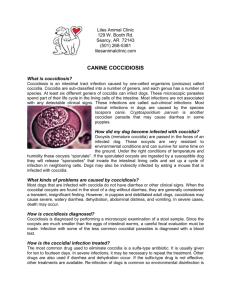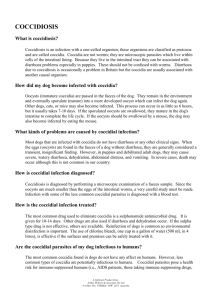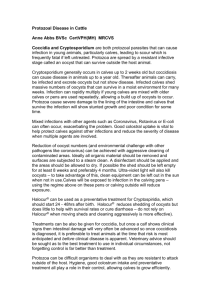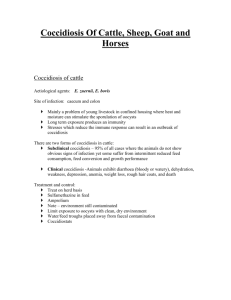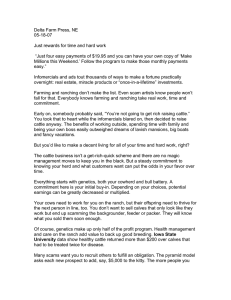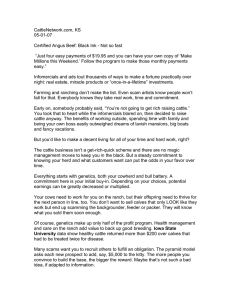Coccidiosis in cattle University of Georgia, College of Veterinary Medicine
advertisement
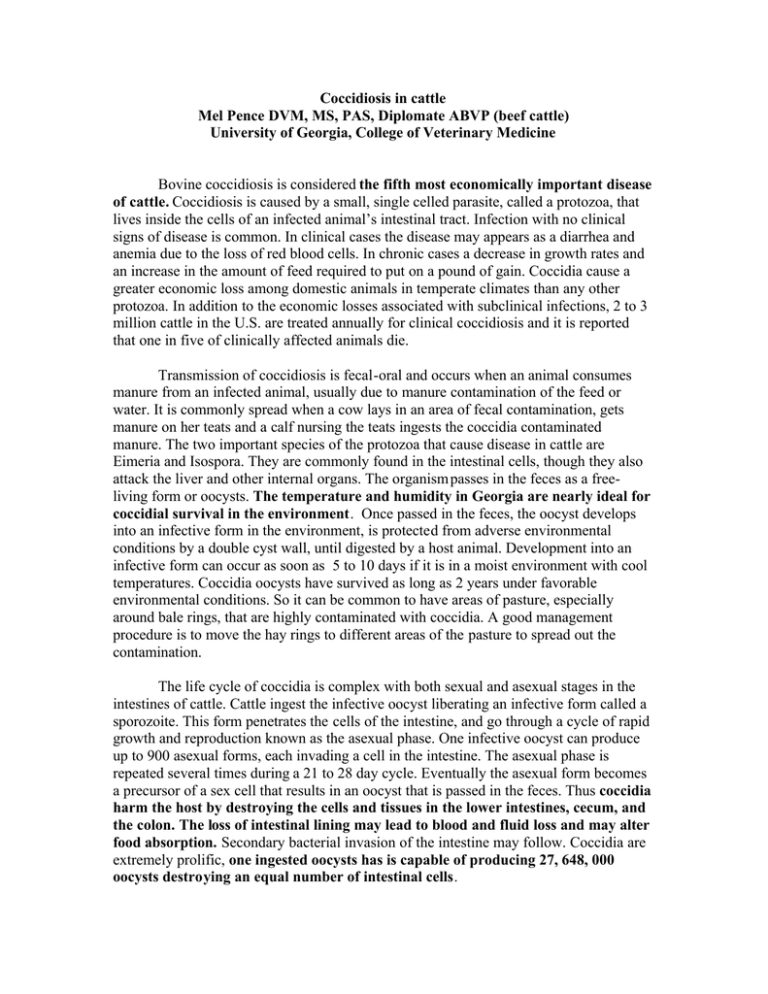
Coccidiosis in cattle Mel Pence DVM, MS, PAS, Diplomate ABVP (beef cattle) University of Georgia, College of Veterinary Medicine Bovine coccidiosis is considered the fifth most economically important disease of cattle. Coccidiosis is caused by a small, single celled parasite, called a protozoa, that lives inside the cells of an infected animal’s intestinal tract. Infection with no clinical signs of disease is common. In clinical cases the disease may appears as a diarrhea and anemia due to the loss of red blood cells. In chronic cases a decrease in growth rates and an increase in the amount of feed required to put on a pound of gain. Coccidia cause a greater economic loss among domestic animals in temperate climates than any other protozoa. In addition to the economic losses associated with subclinical infections, 2 to 3 million cattle in the U.S. are treated annually for clinical coccidiosis and it is reported that one in five of clinically affected animals die. Transmission of coccidiosis is fecal-oral and occurs when an animal consumes manure from an infected animal, usually due to manure contamination of the feed or water. It is commonly spread when a cow lays in an area of fecal contamination, gets manure on her teats and a calf nursing the teats ingests the coccidia contaminated manure. The two important species of the protozoa that cause disease in cattle are Eimeria and Isospora. They are commonly found in the intestinal cells, though they also attack the liver and other internal organs. The organism passes in the feces as a freeliving form or oocysts. The temperature and humidity in Georgia are nearly ideal for coccidial survival in the environment. Once passed in the feces, the oocyst develops into an infective form in the environment, is protected from adverse environmental conditions by a double cyst wall, until digested by a host animal. Development into an infective form can occur as soon as 5 to 10 days if it is in a moist environment with cool temperatures. Coccidia oocysts have survived as long as 2 years under favorable environmental conditions. So it can be common to have areas of pasture, especially around bale rings, that are highly contaminated with coccidia. A good management procedure is to move the hay rings to different areas of the pasture to spread out the contamination. The life cycle of coccidia is complex with both sexual and asexual stages in the intestines of cattle. Cattle ingest the infective oocyst liberating an infective form called a sporozoite. This form penetrates the cells of the intestine, and go through a cycle of rapid growth and reproduction known as the asexual phase. One infective oocyst can produce up to 900 asexual forms, each invading a cell in the intestine. The asexual phase is repeated several times during a 21 to 28 day cycle. Eventually the asexual form becomes a precursor of a sex cell that results in an oocyst that is passed in the feces. Thus coccidia harm the host by destroying the cells and tissues in the lower intestines, cecum, and the colon. The loss of intestinal lining may lead to blood and fluid loss and may alter food absorption. Secondary bacterial invasion of the intestine may follow. Coccidia are extremely prolific, one ingested oocysts has is capable of producing 27, 648, 000 oocysts destroying an equal number of intestinal cells. Cattle usually do not show clinical signs of the disease unless stressed by weaning, weather, shipping or other diseases. It is common for cow/calf producers to have coccidiosis but not see clinical signs of the disease because the calves are shipped at weaning. These calves break with the disease for the backgrounder or the feedlot. Clinically apparent coccidiosis in cattle is deceptive. Clinical signs, if present are often not demonstrated until 3 to 8 weeks after initial infection. Observation of one clinical case in a pen indicates oocyst cycling in other animals in the pen or feedlot, and significantly, most of the damage to the intestinal tract has already occurred. If the infection is mild, the most characteristic sign is foul smelling, dark, and watery feces. Usually no blood is seen in these less severe infections. The animal may have a mild fever, but in most cases its temperature is normal or possibly below normal. Severely affected animals may develop a diarrhea that is thin and bloody. Some cattle will pass formed feces that contain streaks or clots of blood and shreds of mucus. The diarrhea will usually last 3 to 4 days, but may continue for a week or more. The area around the anus and tail is often stained with blood and straining is common. The animals lose their appetite, become depressed and dehydrated, and lose weight. Cattle can also suffer a central nervous disorder from coccidiosis. Affected animals show muscular tremors, convulsions, and bending of the neck and head. Infected calves may die within 24 hours after the onset of dysentery and nervous signs, or they may live for several days, but usually are unable to rise. Nervous coccidiosis is difficult to treat and requires intensive veterinary care if the animal is to survive. A clinical diagnosis is usually made when the characteristic coccidial symptoms, dysentery, straining, mild systemic involvement, and dehydration are present. Coccidial oocycts can be diagnosed by routine microscopic fecal examinations. The presents of fecal oocysts lags behind the onset of clinical signs. Control of coccidiosis in cattle has been based on good management of premise sanitation, treatment of clinical cases as they appear, and especially the use of preventive medications. An infective dose of coccidia is necessary to produce signs of disease. If we keep the level of contamination down by sanitation and preventing contamination of feed and water we will have reduced the economic impact of the disease on the farm and for the buyer of the calves. The oocyst wall provides protection against chemical disinfectants. Coccidia are ubiquitous and unlikely to be destroyed in nature. Therefore, it is not feasible to expect control by treating the external environment. Various combinations of sulfa drugs or amprolium are used to control an outbreak. Symptomatic treatment is necessary to stop the bacterial infections that accompany clinical coccidiosis. Treatment of clinical animals is not very rewarding, since clinical signs result from the final stage of parasite cycling in the host. The most acceptable method of control is prevention achieved by timely medication. The approved drugs for prevention of coccidiosis in cattle are Rumensin, Amprolium, Deccox, and Bovatec. Amprolium is a coccidiostat used as a feed additive or in the drinking water and is best used as a treatment of clinically infected cattle. It is administered continuously for 21 days. It is well tolerated and must be withdrawn at least 24 hours before processing cattle. Deccox is a feed additive that is effectively used as a preventative treatment in confined cattle. It can also be used as treatment to reduce the effects of an acute outbreak. The clinically affected animals should be treated with sulfa drugs, and then the coexistent cattle should receive Amprolium or Deccox to prevent further cycling of the oocysts. The medication should be fed for 28 to 56 days or longer. All incoming cattle should be given some type of preventative treatment for at least 28 days to prevent coccidiosis. Rumensin and Bovetec are growth-promotant feed additives that are also effective at preventing coccidiosis. These products should be used only to prevent subclinical and clinical coccidiosis and not for treatment. In a cow calf situation the usual source of infection is a cow that is shedding the coccidia but has no signs of disease. These cows do not become immune to infection and continuously shed coccidia contaminating the pasture. The solution to coccidia in a cow calf environment is to stop these cows from shedding the coccidia. That can be accomplished by using mineral with Rumensin or Bovetec for the cow herd starting about 45 – 60 days before calving. The most common situation for clinical coccidiosis is in stressed calves that have an unapparent coccidial infection. These calves have small numbers of coccidia in the intestine but not enough to cause clinical disease. Once these calves are stressed they produce large numbers of coccidia and contaminate the environment. This large production of coccidia and subsequent contamination of the environment is commonly seen in calves weaned, sold and commingled with other calves all on the same day. Because our environment in Georgia is conducive to coccidial survival, this stress induced coccidiosis commonly occurs when our calves are sold and is one reason our cattle are discounted when sold. This could be prevented with a program of feeding mineral medicated with Rumensin or Bovetec to the cows prior to the calving season. If the herd has no defined breeding season then an alternative prevention would be to feed mineral with Rumensin or Bovetec to the entire herd most of the year or at least 60 days before weaning.
